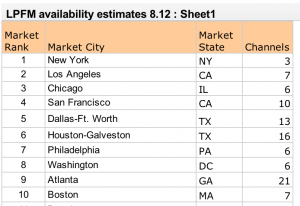How many new LPFM stations will there be? That is one of the biggest questions on the mind of community radio supporters, especially since the FCC’s March ruling resolving the tension between processing the backlog of translator applications and saving room for new low-power stations.
Radio World recently published a short survey of best guesses from the Prometheus Radio Project and NPR Labs, which were both based upon the FCC’s own LPFM availability software. I gave the software a shot myself, but found that it was less than user friendly, and didn’t have the patience to knuckle down and master it. I’m glad there are folks with more patience and smarts than I giving it a go.
Prometheus and NPR Labs break down the data by market. This is useful because one of the biggest concerns is how many stations might go on the air in the largest, most crowded urban radio dials, since these markets missed out on LPFM altogether in the last licensing window. Prometheus estimates that in the top three markets New York will be eligible for 3 stations, Los Angeles 7 and Chicago might get 6. NPR Labs (PDF) makes a more conservative prediction at zero for all three top markets.
The disparity is due to Prometheus including the possibility for “short-spaced” stations that will require a waiver from the FCC along with the recent FCC ruling that dismisses all translator applications in certain parts of certain markets. On the other hand NPR Labs only counts channels that are spaced no closer than the 3rd adjacent, not requiring a waiver, and does not figure in translator dismissals.
Another take on the question comes from Michi Eyre at REC Networks, who wrote in to Radio World to call attention to REC’s “Super Coordinator” program analysis of the FCC data. Rec’s market-by-market tally breaks things down into different categories corresponding to schemes recommended in comments to the FCC, such as proposals to authorize 250 watt and 50 watt stations, in addition to the current 100-watt only regime. Looking only at 100-watt-only standard that is the status quo, Rec sees 3 LPFMs in New York, 11 in Los Angeles and 8 in Chicago.
In this discussion of markets it’s important to point out that these can include municipalities outside the major urban hub. Prometheus looked for open channels in a 20 minute longitude by 20 minute latitude grid around the center of each market, which amounts to an area of roughly 23 square miles.
REC’s estimates are for the market’s main city, as shown in breakdowns for the major markets. Each lists the municipalities and zip codes where different classes of stations may be permitted. For instance, in my home market of Chicago REC shows that all 8 possible stations in the city itself will require a waiver from the FCC. The 3 New York City stations also will require a waiver, and are located in State Island and Brooklyn; none are in Manhattan.
While Prometheus’ and REC’s estimates are relatively optimistic for LPFM in major cities, there are still issues that the FCC has to resolve before a more accurate count can be made. One is the suggestion of increasing top power levels to 250 watts, which would increase broadcast area, but also impact where a station may be situated. Nevertheless, the potential for true low-power community stations in major urban areas is exciting, and I’m eager to see how the next licensing window develops.



